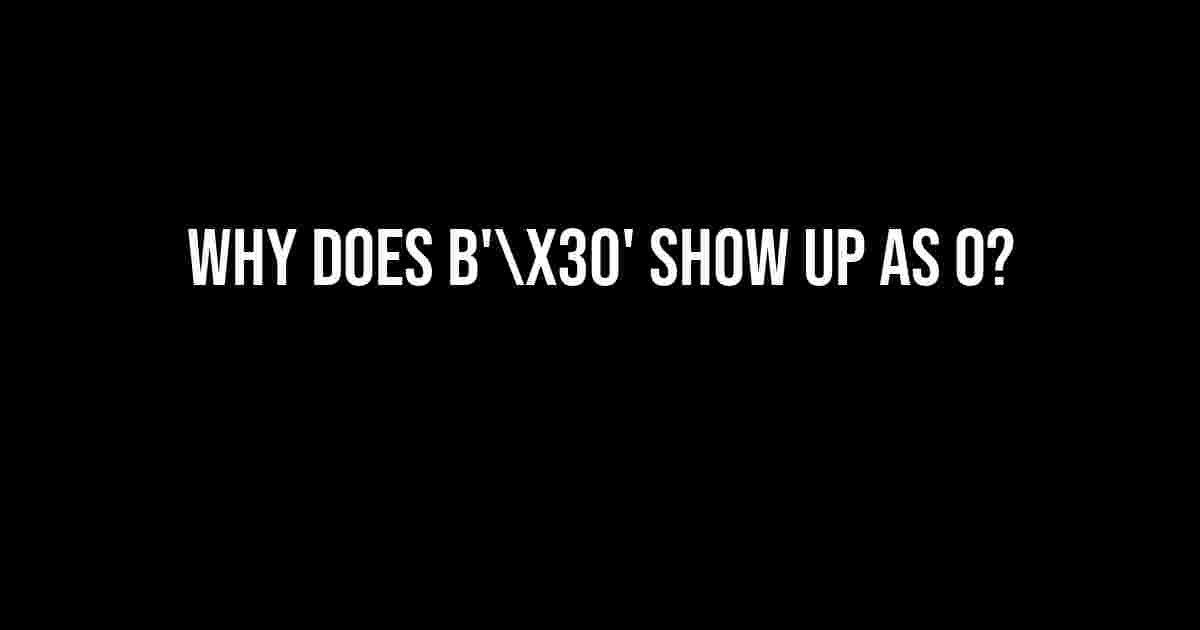Have you ever wondered why the seemingly innocuous string “b'\x30'” magically transforms into the digit 0? It’s a phenomenon that has puzzled many a developer, and for good reason. In this article, we’ll dive into the depths of character encoding, escape sequences, and the quirks of programming languages to unravel the mystery behind this enigmatic behavior.
The Mysterious Case of b'\x30'
Let’s start by examining the string in question: b'\x30'. At first glance, it may appear to be a random collection of characters, but each element plays a crucial role in the transformation process.
The “b” prefix
In many programming languages, particularly Python, the “b” prefix is used to denote a byte string literal. This means that the string is encoded using ASCII or another character encoding standard, and each character is represented by a single byte.
The “'” escape sequence
The “'” sequence is an escape sequence used to represent a single quote (‘) character. In string literals, the backslash (\) is used to escape special characters, and “'” is the escaped form of the single quote.
The “\x30” hexadecimal code
The “\x” prefix is used to denote a hexadecimal code point. In this case, “\x30” represents the Unicode code point for the digit 0 (U+0030). When the string is parsed, the hexadecimal code is replaced with the corresponding character.
How b'\x30' Becomes 0
Now that we’ve dissected the individual components of the string, let’s see how they come together to produce the unexpected result.
- The “b” prefix indicates that the string is a byte string literal.
- The “'” escape sequence is replaced with a single quote (‘) character.
- The “\x30” hexadecimal code is replaced with the Unicode character for the digit 0 (U+0030).
- The resulting string, consisting of a single quote followed by the digit 0, is parsed as a string literal.
- In many programming languages, including Python, a string containing a single digit is implicitly converted to an integer value.
- As a result, the string “b'\x30'” is evaluated as the integer value 0.
Practical Implications and Workarounds
While the transformation of b'\x30' to 0 may seem obscure, it has significant implications in real-world programming scenarios.
For example, consider the following Python code:
x = b'\x30'
print(x) # Output: b'0'
print(int(x)) # Output: 0
In this example, the byte string literal b’\x30′ is assigned to the variable x. When printed as a string, the output is b’0′, as expected. However, when converted to an integer using the int() function, the value becomes 0.
To avoid this behavior, it’s essential to ensure that your strings are properly encoded and decoded. Here are some best practices to keep in mind:
- Use Unicode string literals (e.g., u’\x30′) instead of byte string literals (e.g., b’\x30′).
- Specify the encoding of your strings using the encoding parameter (e.g., ‘utf-8’).
- Use the decode() method to explicitly convert byte strings to Unicode strings.
- Avoid implicit conversions between strings and integers.
Conclusion
In conclusion, the transformation of b'\x30' to 0 is a complex phenomenon that arises from the interplay of character encoding, escape sequences, and implicit type conversions. By understanding the underlying mechanisms, you can avoid common pitfalls and ensure that your code behaves as expected.
Remember, in the world of programming, even the most seemingly innocuous strings can hold hidden surprises. Stay vigilant, and always keep your encoding and decoding skills sharp!
| Character/Sequence | Description |
|---|---|
| b | Byte string literal prefix |
| ' | Escape sequence for single quote (‘) |
| \x30 | Hexadecimal code for Unicode character U+0030 (digit 0) |
Now that you’ve mastered the mysteries of b'\x30', go forth and conquering the world of character encoding and string manipulation!
Frequently Asked Question
Ever wondered why b’\x30′ shows up as 0? Well, we’ve got the answers for you!
Why does b’\x30′ show up as 0 in Python?
In Python, the `b` prefix indicates a bytes literal, and `\x30` is an escaped hexadecimal value representing the character `0`. When Python interprets this literal, it converts the hexadecimal value to its corresponding character, resulting in the string `’0’`. The `b` prefix tells Python to treat the resulting string as a bytes object instead of a Unicode string, which is why you see `b’0’` instead of just `’0’`.
What is the difference between a bytes object and a Unicode string in Python?
In Python, a bytes object represents a sequence of bytes, which are the basic units of information in computing. A Unicode string, on the other hand, represents a sequence of Unicode characters, which are abstract symbols used to represent human language. When you prefix a string with `b`, Python treats it as a bytes object, whereas without the prefix, it’s treated as a Unicode string. Think of bytes as the raw, binary data, and Unicode strings as the human-readable representation of that data.
Why do I need to use the `b` prefix in Python?
You need to use the `b` prefix when working with binary data, such as reading or writing files, networks, or databases. This prefix tells Python to treat the string as a sequence of bytes, rather than a sequence of Unicode characters. This is essential when working with binary data, as the `b` prefix ensures that Python doesn’t attempt to interpret the data as Unicode, which could lead to corruption or errors.
What is the `\x` notation in Python?
In Python, the `\x` notation is used to represent a character using its hexadecimal code point. For example, `\x30` represents the character `0`, `\x41` represents the character `A`, and so on. This notation is called an “escaped hexadecimal value”. It allows you to specify characters using their hexadecimal code points, which can be useful when working with binary data or ASCII art.
Can I use the `b` prefix with other types of literals in Python?
No, the `b` prefix is specific to string literals in Python. You can’t use it with other types of literals, such as integer, float, or Boolean literals. The `b` prefix is a way to specify that a string literal should be treated as a bytes object, and it only applies to string literals. If you try to use it with other types of literals, Python will raise a `SyntaxError`.


